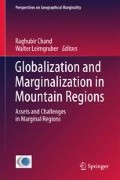Abstract
To the best of our knowledge, no country, or region, has remained as forbidden to foreigners as Tibet. Geography and history have conspired with politics to make access difficult, and religious curiosity and practice has made it tantalizing and highly vulnerable to brute muscle power. But the High Himalayan wall has helped in moulding and shaping a set of ‘border people’, enduring the harshest possible physical conditions and overcoming them in a near super human effort. This is the main theme of this chapter. It is the outcome of the 8th Pundit Nain Singh Lecture delivered in Munsyari, the home land of the Pundit brothers. The author concluded that the real credit for opening the doors of Tibet should really go to Tibet’s founder-king Songtsen Gampo (617–649 A.D.) who sent Thon-mi Sam Bhota with 16 companions to India (Kashmir) to learn the Sanskrit language. After his return to Tibet he used his knowledge of the Brahmi and Gupta scripts to devise a Tibetan script. Atisha, Santirakshita and Guru Padmsambhav are but a few names who helped establish Buddhism in Tibet, while it declined in its country of birth. Nain Singh and Kishan Singh were following the footsteps of learned Buddhist savants like Santirakshita, Atisha and Padmsambhava, while the former simply abided by the request made by the Tibetan kings to extend to them the teachings of the greatest reformer India had gifted to the world. These ‘Pundits’ were filling up the ‘white spots’ with which our modern day scientific community is battling with.
Access this chapter
Tax calculation will be finalised at checkout
Purchases are for personal use only
Notes
- 1.
Personal communication from interviews in the settlement of Bidang in Darma.
- 2.
“The term Mongoloid has come to mean demented physical and mental developments, features similar to the Asiatic race. A more appropriately neutral, modern term would thus be the East Asian race, from Mongolians, Koreans, Chinese and Japanese in the North to Burmese, Laotians, Cambodians, Vietnamese, Thais, Malaysians, Singaporeans, Filipinos and Indonesians in the South” (Chong 2009, p. 3).
- 3.
For the sake of record, and to provide a sense of the extent of this recorded scientific information, let me provide brief details of Nain Singh’s celebrated four survey explorations in Tibet and Central Asia (1865–1875): 1865–66: Kathmandu—Lhasa—Mansarovar Lake (21 months, 1200 mi), 1867: Origin of Sutlej and Indus rivers, and Thok Jalung in Tibet (7 months, 850 mi), 1873–74: Douglas Forsyth’s Second Yarkand—Kashgar Mission, and 1873–75: Leh—Lhasa—Tawang, Assam (1319 mi).
References
Alcock, R. (1877). Address to the Royal Geographical Society. Journal of the Royal Geographical Society of London, 47, pp. cxxxiii–cciii.
Allender, T. (2006). Ruling through education: The politics of schooling in the colonial Punjab. New Delhi: New Dawn Press.
Bhatt, U., & Pathak, S. (Eds.). (2006). Asia Ki Peeth Par: Pandit Nain Singh Rawat. PAHAR: Nainital.
Chong, Y. L. (2009). Southeast Asia. The long road ahead (3rd ed.). Singapore: World Scientific Publishing Company.
Mir, F. (2010). The Social Space of Language: Vernacular Culture in British Colonial Punjab. Oakland: University of California Press.
Schlagintweit, A., & Schlagintweit, R. (1861–66). Results of a Scientific Mission to India and High Asia (Vols. 1–IV, 1861–1863 and 1866). Leipzig/London: F.A. Brockhhans Trubner & Co.
Sherring, C. A. (2006). The Bhotias of Almora and Garhwal.
Singh, R. I. (1973). Indian Explorers of the 19th Century. New Delhi: Publications Division.
Tolia, R. S. (2000). Dhamu Budha Ke Vanshaj (2nd ed.). UP Johar Sanskritik Sangathan: Lucknow.
Tolia, R. S. (2005). Mana, Malari and Milam: Extremes of human endurance, Tour notes of a Chief Secretary. Dehradun, Uttarakhand: Shiv Offset Press.
Tolia, R. S., & Prakashan, J. (Eds.). (2010). Johar Itihas Samagra. Malla Johar Vikas Samiti: Munsyari & Pitoragarh.
Tsepon, W. D. S. (1984). Tibet: A political History. New York: Potala Publication.
Acknowledgements
I would like to thank the convener of the IGU Commission conference Nainital 2011, Professor Raghubir Chand, for inviting me to deliver this lecture. He has afforded me this opportunity to share some of my time with the participants from across the world and share this information with them, in the company of able teachers and young students of our Munsyari region. I also thank Prof. Shekhar Pathak and Dr. Sher Singh Pangtey who have made outstanding contributions to bring to notice the life and works of these relatively unknown scientific explorers to the outside world.
Author information
Authors and Affiliations
Corresponding author
Editor information
Editors and Affiliations
Rights and permissions
Copyright information
© 2016 Springer International Publishing Switzerland
About this chapter
Cite this chapter
Tolia, R.S. (2016). Opening the Door of Tibet. In: Chand, R., Leimgruber, W. (eds) Globalization and Marginalization in Mountain Regions. Perspectives on Geographical Marginality, vol 1. Springer, Cham. https://doi.org/10.1007/978-3-319-32649-8_2
Download citation
DOI: https://doi.org/10.1007/978-3-319-32649-8_2
Published:
Publisher Name: Springer, Cham
Print ISBN: 978-3-319-32648-1
Online ISBN: 978-3-319-32649-8
eBook Packages: Social SciencesSocial Sciences (R0)

